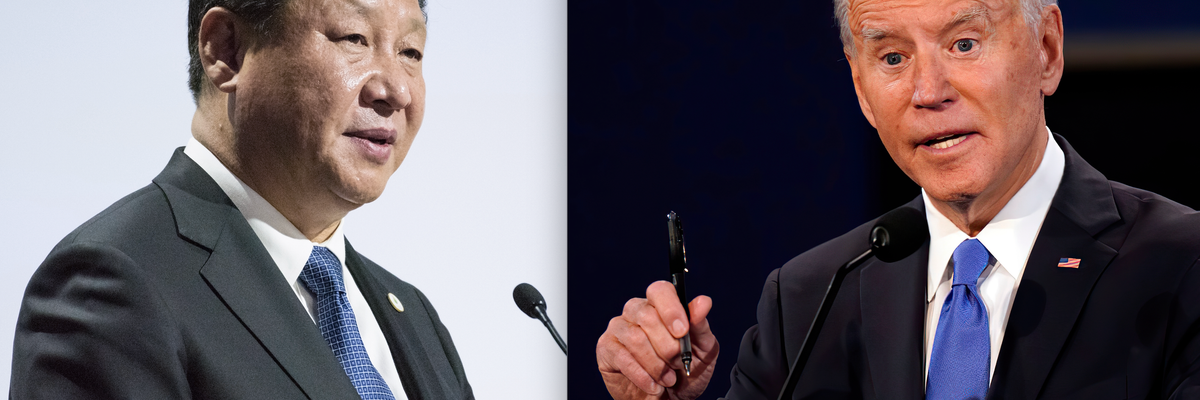Leaders from the United States, United Kingdom, and Australia jointly announced on Wednesday the launch of a new strategic partnership — AUKUS — that is widely seen as aimed at China. The partnership is the clearest signal yet that, following the withdrawal from Afghanistan, the Biden administration is reorienting U.S. foreign policy around competition with China and doubling-down on a confrontational approach that will likely continue through the remainder of Biden’s presidency.
AUKUS comes with a broad mandate, including strengthening trilateral cooperation in key domains such as cybersecurity, artificial intelligence, quantum technologies, and missile development, and fostering “deeper integration of security- and defense-related science, technology, industrial bases, and supply chains,” in the words of Secretary of State Antony Blinken.
But its first order of business will be to help Australia develop a fleet of eight nuclear-powered, conventionally-armed submarines after an interim consulatory period lasting 18 months. Although many have expressed concern that the move may weaken the global nuclear nonproliferation regime, it also has significant implications for the balance of power and a brewing arms race in the Asia-Pacific.
This type of submarine does not have nuclear launch capabilities, but rather is powered by a nuclear reactor that makes them “faster, more capable, harder to detect and potentially much more lethal than conventionally-powered submarines,” according to the Washington Post. They will enable Australia to more actively participate in missions further from its shores, particularly in the South China Sea and near Taiwan.
However, the U.S. Navy already has an overwhelming advantage in this domain, counting more than 50 nuclear-powered submarines (SSNs) among its fleet; all three of its most powerful Seawolf-class of SSNs were deployed to the Asia-Pacific over the summer. China, by contrast, has a large diesel-electric fleet, but only six that are nuclear-powered, with others expected to come over the next decade according to the U.S. Department of Defense.
The move to bolster Australia’s capabilities is thus designed to ensure that the regional balance of power continues to remain imbalanced, tilted heavily in AUKUS’s favor. For the last three decades, China’s defense policy has been animated around the need to offset the advantages of the United States and its allies in order to counter a possible military intervention in the event of a crisis. The formation of AUKUS and the deployment of additional SSNs will only reinforce China’s sense of insecurity, pushing it to double-down on efforts to secure a degree of strategic breathing room in its own backyard.
“Nothing is more provocative to China than nuke stuff and submarine stuff,” Oriana Skylar Mastro, a fellow at Stanford University’s Freeman Spogli Institute for International Studies and the American Enterprise Institute, told the New York Times. “China’s so weak in anti-submarine warfare in comparison to other capabilities.”
Hugh White, a former Australian defense official and longstanding skeptic of where U.S.-China competition is taking the region, also told the New York Times that “the Australian decision to go this way is not just a decision to go for a nuclear-powered submarine. It’s a decision to deepen and consolidate our strategic alignment with the United States against China.”
“This just further deepens the sense that we do have a new Cold War in Asia,” White continued, “and that Australia is betting that in that new Cold War, the U.S. is going to emerge victorious.”
Asked about AUKUS, Chinese foreign ministry spokesperson Zhao Lijian called it an “extremely irresponsible” move that “has seriously undermined regional peace and stability.” Regional security mechanisms “should not target any third party or undermine its interests,” Zhao continued. “Seeking [a] closed and exclusive clique runs counter to the trend of the times and the aspirations of countries in the region,” and those sticking to this “outdated Cold War zero-sum mentality… will only end up shooting themselves in the foot.” Indonesia, which has territorial disputes with China in the South China Sea, also expressed its deep concern “over the continuing arms race and power projection in the region.”
However, the move must also be understood in its broader political context, particularly the critical but overlooked changes that have taken place in the U.S.-China relationship over the prior two months, as well as the last week. Ever since Deputy Secretary of State Wendy Sherman visited China in July for face-to-face meetings with her counterparts, the first such meetings held since a contentious showdown in Alaska back in March, the bilateral relationship has been in a sort of limbo.
The ice appeared to break last Thursday, when Biden reached out to Chinese President Xi Jinping for a 90-minute phone call, the first time the two had spoken in seven months. Although both agreed on the need to avoid conflict and continue to engage in dialogue, any spirit of bonhomie was quickly spoiled by a series of announcements the Biden administration made shortly after the call.
Less than 24 hours after Biden and Xi spoke, reports quoting administration officials said that Washington was holding talks with top Taiwanese officials later that day, and was also considering changing the name of Taiwan’s representative office, a very sensitive issue for Beijing that previously landed Lithuania in hot water. News also broke that the administration was considering launching a new Section 301 investigation that could result in new tariffs, and that the White House would be hosting an in-person summit of the Quad next week.
This is the backdrop upon which AUKUS must be understood: it is another clear signal, possibly the strongest yet, that the Biden administration was not satisfied with the call with Xi, and is looking to build up additional sources of leverage and pressure to set the future direction of the relationship on Washington’s terms. This aligns with claims made by top officials since the beginning of Biden’s presidency that Washington will only engage Beijing from a “position of strength.”
But ultimately, the administration’s strategy is not credible. Its sole animating goal appears to be using this “position of strength” to force Beijing to back down and buckle on issues that it has long said are red lines and central to its foreign policy. Beijing will naturally respond by turning up the heat in its own right in order to signal resolve; the administration, as well as the vast majority of Washington’s foreign policy elite, have chosen to be willfully blind to these escalatory dynamics, believing that things will simply work out in America’s favor.
However, as the revelations about Joint Chiefs chair General Milley’s two calls to Chinese military officials in the waning months of the Trump administration make clear, rising tensions run the constant risk of sparking misunderstandings that might suddenly push the two countries to the brink of conflict at any moment. Biden may be more stable and measured than his predecessor, but he is setting the relationship on a course that no one can truly control. The longer that this pattern is allowed to set in, the more likely it is to define the relationship for decades to come; continuing to escalate without offering a credible off-ramp or exit plan is little more than gambling with the lives of hundreds of millions across Asia and beyond, with bad odds of success to boot.
















